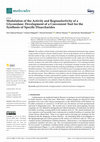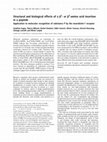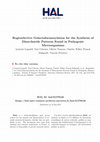Papers by Olivier Tasseau
HAL (Le Centre pour la Communication Scientifique Directe), 2010
International audienc
HAL (Le Centre pour la Communication Scientifique Directe), 2009
International audienc
Soft Matter
The water-sensitivity of (arylboronate alkylglucoside)-based organogels was investigated from a s... more The water-sensitivity of (arylboronate alkylglucoside)-based organogels was investigated from a series of twelve potential organogelators.
Keywords: 19F/1H HOESY; gem-difluoroalkyl derivatives; organo-fluorine compounds; palladium catal... more Keywords: 19F/1H HOESY; gem-difluoroalkyl derivatives; organo-fluorine compounds; palladium catalysis; pyrazolines; pyrrolines

Chemical Biology & Drug Design, 2022
Proline racemases (PRAC), catalyzing the L-proline and D-proline interconversion, are essential f... more Proline racemases (PRAC), catalyzing the L-proline and D-proline interconversion, are essential factors in eucaryotic pathogenes such as Trypanosoma cruzi, Trypanosoma vivax and Clostridioides difficile. If the discovery of irreversible inhibitors of Trypanosoma cruzi PRAC (TcPRAC) led to innovative therapy of the Chagas disease, no inhibitors of CdPRAC have been discovered to date. However, Clostridioides difficile, due to an increased incidence in recent years, is considered as a major cause of health threat. In this work, we have taken into account the similarity between TcPRAC and CdPRAC enzymes to design new inhibitors of CdPRAC. Starting from (E) 4-oxopent-2-enoic acid TcPRAC irreversible inhibitors, we synthesized 4-aryl substituted analogues and evaluated their CdPRAC enzymatic inhibition against eleven strains of Clostridioides difficile. This study resulted in promising candidates and allowed for identification of (E)-4-(3-bromothiophen-2-yl)-4-oxobut-2-enoic acid 20 that was chosen for complementary in vivo studies and did not reveal in vivo toxicity.
Organic & Biomolecular Chemistry
This paper describes the synthesis and biological evaluation of new inhibitors of anti-apoptotic ... more This paper describes the synthesis and biological evaluation of new inhibitors of anti-apoptotic proteins towards novel anti-cancer agents.

Molecules
The synthesis of disaccharides, particularly those containing hexofuranoside rings, requires a la... more The synthesis of disaccharides, particularly those containing hexofuranoside rings, requires a large number of steps by classical chemical means. The use of glycosidases can be an alternative to limit the number of steps, as they catalyze the formation of controlled glycosidic bonds starting from simple and easy to access building blocks; the main drawbacks are the yields, due to the balance between the hydrolysis and transglycosylation of these enzymes, and the enzyme-dependent regioselectivity. To improve the yield of the synthesis of β-d-galactofuranosyl-(1→X)-d-mannopyranosides catalyzed by an arabinofuranosidase, in this study we developed a strategy to mutate, then screen the catalyst, followed by a tailored molecular modeling methodology to rationalize the effects of the identified mutations. Two mutants with a 2.3 to 3.8-fold increase in transglycosylation yield were obtained, and in addition their accumulated regioisomer kinetic profiles were very different from the wild-ty...
Chemistry – A European Journal
Organic & Biomolecular Chemistry
Standard glycosylation of unprotected 6-fluorogalactofuranoside turned to three competitive react... more Standard glycosylation of unprotected 6-fluorogalactofuranoside turned to three competitive reactions and afforded difuranosides able to impact growth of Leishmania tarentolae.
Organic & Biomolecular Chemistry
Galactofuranoconjugates are rare compounds with interesting biological properties. Their synthese... more Galactofuranoconjugates are rare compounds with interesting biological properties. Their syntheses by traditional approaches are however tedious. Glycosidases are nowadays often used to simplify such synthesis but no galactofuranosidase has been...
Medicinal Chemistry Research

Analytical Chemistry, 2003
Photoreactive analogues of substance P (biotin sulfone-spacer (amino pentanoic or Gly(3))-Arg-Pro... more Photoreactive analogues of substance P (biotin sulfone-spacer (amino pentanoic or Gly(3))-Arg-Pro-Lys-Pro-(pBzl)Phe-Gln-Phe-Phe-Gly-Leu-Met(O(2))NH(2)) with or without isotope (deuterium) labeling have been synthesized. Deuteriums were present on (d)-biotin or epibiotin sulfone (D(3)), on the Gly(3) spacer linker (D(6)), or on the Gly in position 9 of SP (D(2)). Therefore, peptide analogues could be either unlabeled or tri-, penta-, or hexadeuterated. Results obtained with the use of these peptide analogues show that (d)-biotin sulfone and epibiotin sulfone are not recognized with the same affinity by streptavidin, with (d)-biotin sulfone displaying better affinity for the protein. Photolabeling of the human NK-1 receptor with a 1:1 molar ratio of nondeuterated and deuterated photoreactive substance P (SP) analogues in position 5, followed by combined digestions, purification, and MALDI-TOF mass spectrometry analysis, made the identification of the domain of the receptor covalently linked by the photoreactive SP analogue easier. Indeed, doublets in mass spectra were specific for the covalent complex whereas single peaks could be attributed to contaminating species. This method is particularly suitable when minute amounts of complex have to be analyzed, as in the case of highly hydrophobic G-protein coupled receptors.

European journal of biochemistry / FEBS, 2003
Molecular mechanics calculations on conformers of Ac-HGly-NHMe, Ac-beta2-HAla-NHMe and Ac-beta3-H... more Molecular mechanics calculations on conformers of Ac-HGly-NHMe, Ac-beta2-HAla-NHMe and Ac-beta3-HAla-NHMe indicate that low-energy conformations of the beta-amino acids backbone, corresponding to gauche rotamers around the Calpha-Cbeta bond, may overlap canonical backbone conformers observed for alpha-amino acids. Therefore, Substance P (SP) was used as a model peptide to analyse the structural and biological consequences of the substitution of Phe7 and Phe8 by (R)-beta2-HPhe and of Gly9 by HGly (R)-beta2-HAla or (S)-beta3-HAla. [(R)-beta2-HAla9]SP has pharmacological potency similar to that of SP while [HGly9]SP and [(S)-beta3-HAla9]SP show a 30- to 50-fold decrease in biological activities. The three analogues modified at position 9 are more resistant to degradation by angiotensin converting enzyme than SP and [Ala9]SP. NMR analysis of these SP analogues suggest that a beta-amino acid insertion in position 9 does not affect the overall backbone conformation. Altogether these data ...

European Journal of Biochemistry, 2003
Molecular mechanics calculations on conformers of Ac-HGly-NHMe, Ac-b 2-HAla-NHMe and Ac-b 3-HAla-... more Molecular mechanics calculations on conformers of Ac-HGly-NHMe, Ac-b 2-HAla-NHMe and Ac-b 3-HAla-NHMe indicate that low-energy conformations of the b-amino acids backbone, corresponding to gauche rotamers around the Ca-Cb bond, may overlap canonical backbone conformers observed for a-amino acids. Therefore, Substance P (SP) was used as a model peptide to analyse the structural and biological consequences of the substitution of Phe7 and Phe8 by (R)-b 2-HPhe and of Gly9 by HGly (R)-b 2-HAla or (S)-b 3-HAla. [(R)-b 2-HAla9]SP has pharmacological potency similar to that of SP while [HGly9]SP and [(S)-b 3-HAla9]SP show a 30-to 50-fold decrease in biological activities. The three analogues modified at position 9 are more resistant to degradation by angiotensin converting enzyme than SP and [Ala9]SP. NMR analysis of these SP analogues suggest that a b-amino acid insertion in position 9 does not affect the overall backbone conformation. Altogether these data suggest that [HGly9]SP, [(S)-b 3-HAla9]SP and [(R)-b 2-HAla9]SP could adopt backbone conformations similar to that of SP, [Ala9]SP and [Pro9]SP. In contrast, incorporation of b 2-HPhe in position 7 and 8 of SP led to peptides that are almost devoid of biological activity. Thus, a b-amino acid could replace an a-amino acid within the sequence of a bioactive peptide provided that the additional methylene group does not cause steric hindrance and does not confine orientations of the side chain to regions of space different from those permitted in the a-amino acid.

Analytical Chemistry, 2003
Photoreactive analogues of substance P (biotin sulfone-spacer (amino pentanoic or Gly(3))-Arg-Pro... more Photoreactive analogues of substance P (biotin sulfone-spacer (amino pentanoic or Gly(3))-Arg-Pro-Lys-Pro-(pBzl)Phe-Gln-Phe-Phe-Gly-Leu-Met(O(2))NH(2)) with or without isotope (deuterium) labeling have been synthesized. Deuteriums were present on (d)-biotin or epibiotin sulfone (D(3)), on the Gly(3) spacer linker (D(6)), or on the Gly in position 9 of SP (D(2)). Therefore, peptide analogues could be either unlabeled or tri-, penta-, or hexadeuterated. Results obtained with the use of these peptide analogues show that (d)-biotin sulfone and epibiotin sulfone are not recognized with the same affinity by streptavidin, with (d)-biotin sulfone displaying better affinity for the protein. Photolabeling of the human NK-1 receptor with a 1:1 molar ratio of nondeuterated and deuterated photoreactive substance P (SP) analogues in position 5, followed by combined digestions, purification, and MALDI-TOF mass spectrometry analysis, made the identification of the domain of the receptor covalently linked by the photoreactive SP analogue easier. Indeed, doublets in mass spectra were specific for the covalent complex whereas single peaks could be attributed to contaminating species. This method is particularly suitable when minute amounts of complex have to be analyzed, as in the case of highly hydrophobic G-protein coupled receptors.

The Journal of Organic Chemistry
Koenigs-Knorr glycosylation of acceptors with more than one free hydroxyl group by 2,3,5,6-tetrab... more Koenigs-Knorr glycosylation of acceptors with more than one free hydroxyl group by 2,3,5,6-tetrabenzoyl galactofuranosyl bromide was performed using diphenylborinic acid 2-aminoethyl ester (DPBA) as inducer of regioselectivity. High regioselectivity for the glycosylation on the equatorial hydroxyl group of the acceptor was obtained thanks to the transient formation of a borinate adduct of the corresponding 1,2-cis diol. Nevertheless formation of orthoester by-products hampered the efficiency of the method. Interestingly electron-withdrawing groups on O-6 or on C-1 of the acceptor displaced the reaction in favour of the desired galactofuranosyl containing disaccharide. The best yield was obtained for the furanosylation of p-nitrophenyl 6-O-acetyl mannopyranoside. Precursors of other disaccharides, found in the glycocalix of some pathogens, were synthesized according to the same protocol with yields ranging from 45 to 86%. This is a good alternative for the synthesis of biologically relevant glycoconjugates.







Uploads
Papers by Olivier Tasseau